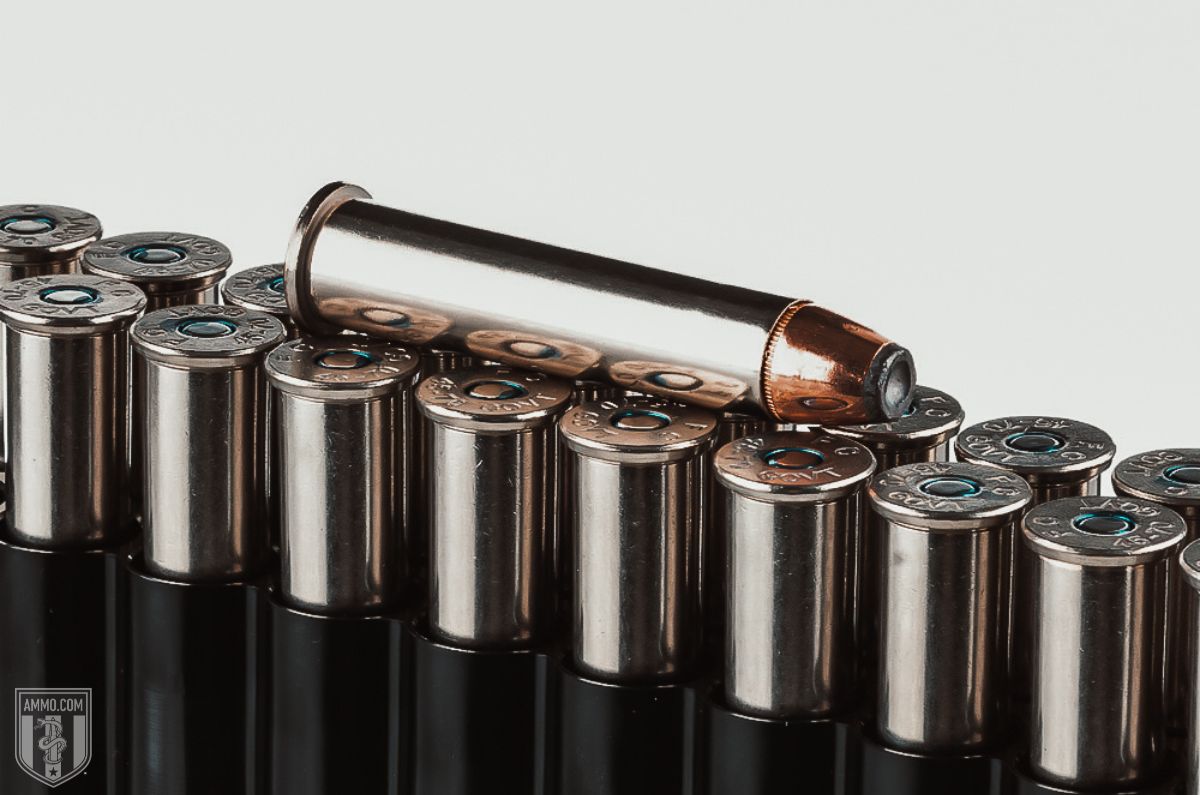38 55 vs 45 70: Is Bigger Always Better?
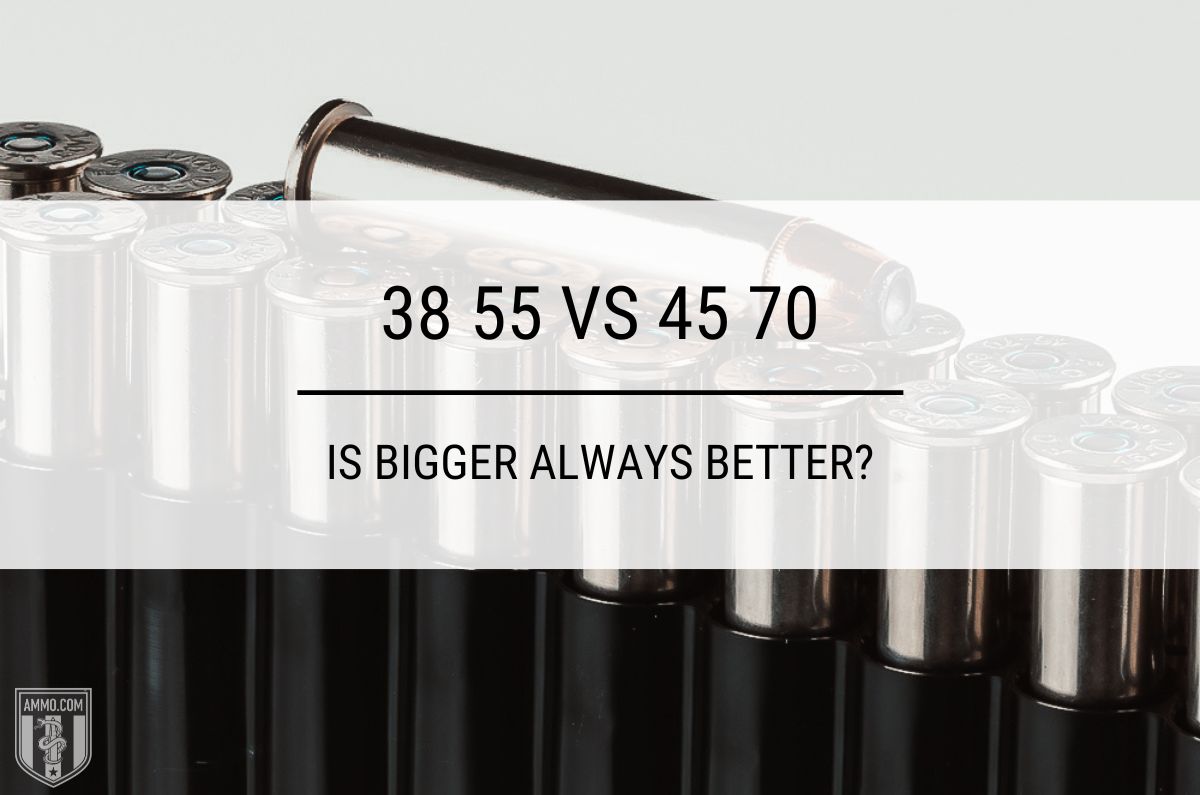
Few rounds are as iconic as the .45-70, which has withstood the test of time. Would you believe me if I told you there was another time-tested option with less kick?
The .38-55 Winchester is that option, but can it hang with its big-bore counterpart?
We're pitting the 38 55 vs 45 70 to see which one you should consider for your next rifle purchase.
38 55 vs 45 70: The Battle Between Two Bores
The 38-55 is a medium-bore caliber, while the 45-70 is a big-bore rifle cartridge, so we should expect to see a considerable difference in cartridge specs and performance, but is that actually the case?
Cartridge Specs
The differences in cartridge specs between these calibers are not as drastic as we might first assume.
The .38-55 has a bullet diameter of 0.3775", which is most commonly 255 gr.
The .45-70 has a 0.458 bullet diameter, which is commonly a 300 gr or 405-grain bullet.
The case length for the 38-55 is 2.085 inches and an overall length of 2.51".
The .38-55 has a higher pressure of 35,000 psi, while the max pressure for the .45-70 is only 28,000 psi.
The .38.-55 rifling twist is 1-18", and the barrel twist rate for the .45-70 is 1-20".
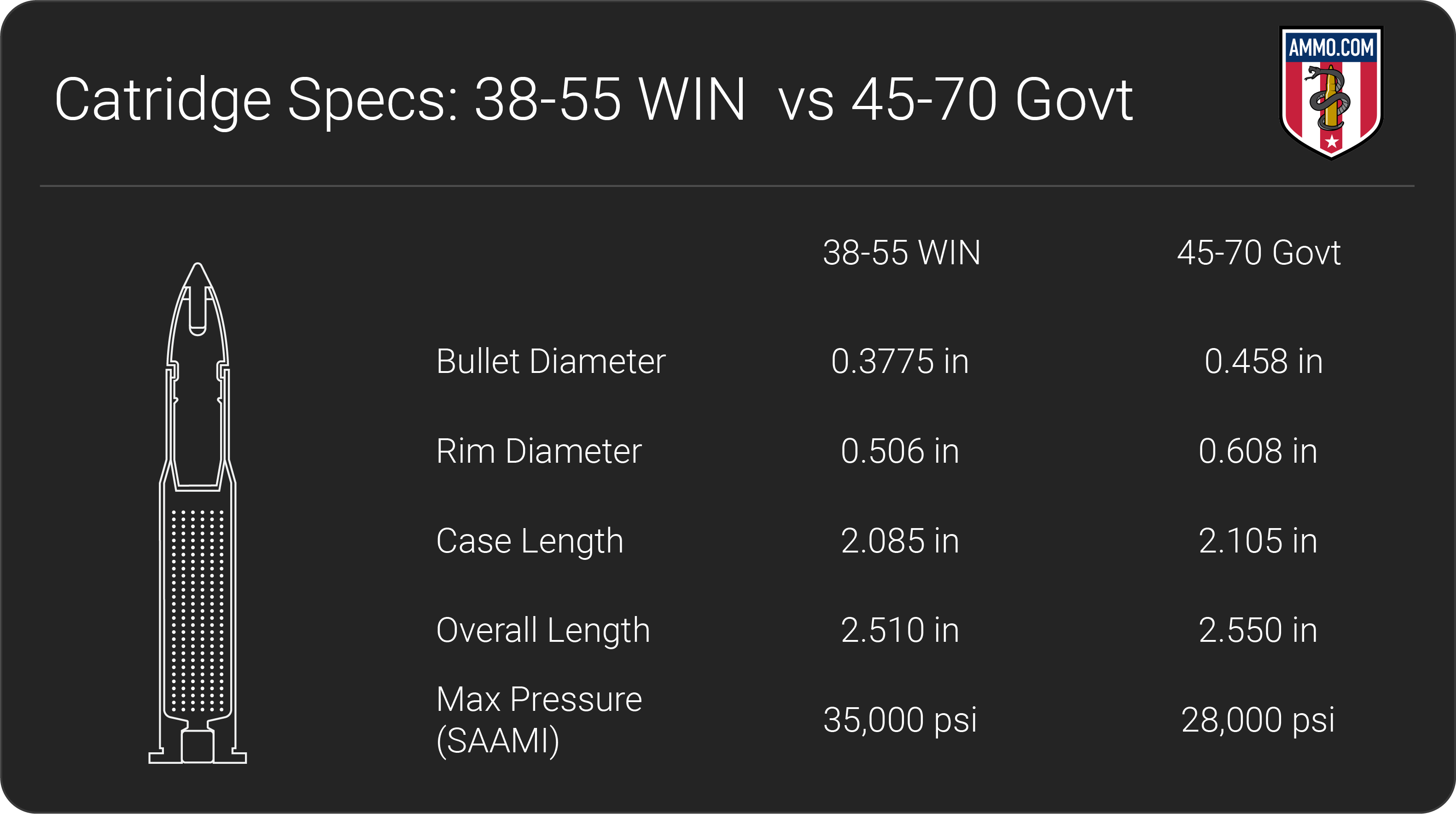
Now that we know the slight differences in the cartridges let's see how much this affects real-world applications.
38-55 vs 45-70: Recoil
If you're basing your decision solely on recoil, go with the 38-55. It has less recoil than the 45-70.
Recoil varies depending on several factors. The gun weight, bullet size, and the shooter determine recoil.
Usually, the larger the bullet, the harder a gun kicks. If you have a heavier gun, it won't kick as hard because the weight of the firearm absorbs some of the recoil.
How well the shooter shoulders the rifle will also determine how much free recoil they feel.
However, the .38-55 Winchester recoils less than the .45-70 Govt.
The .38-55 has 7.8 ft-lb of recoil, and the .45-70 has a shoulder whopping 33.5 ft-lbs of felt recoil.
If you think bigger is always better, then you'll love the .45-90 vs .45-70. When it comes to recoil, the .45-70 seems manageable compared to the .45-90's 42.5 foot-pounds of energy slamming into your shoulder.
The .38-55 wins this section by a landslide.
Trajectory
The trajectory is the measure of a bullet's path to the target. It is an arch due to gravity.
By modern standards, these calibers are not your typical long-range choices. For ethical hunting purposes, they both max out between 300-400 yards.
For target shooting, it's a different story.
The .38-55 can reach 500 yards; however, you have to compensate for an insane drop, so it's best to shoot 300yds and closer.
The .45-70 doesn't fair much better, considering at 300yds, it has 50 inches of drop, and the 45 70 max effective range is 1,000yds.
It's good to keep in mind these are estimates and not hard facts because so many factors go into the bullet's trajectory.
However, one thing is sure; the .45-70 outperforms the .38-55, which is the flattest shooting round.
45-70 vs 38-55: Accuracy
Accuracy is another fickle comparison that depends on several factors.
In general, the less recoil a firearm has, the more accurate anyone can be with it. However, to complicate matters, it also depends on the bullet you are firing, as some guns like specific bullets better than others, depending on sight and weight.

We can forget that it's much easier to be consistently accurate with a flat shooting round, so with all this in mind, which one is the most accurate?
I still lean towards the 38-55 because recoil affects the average shooter more than anything else.
Considering that we use the ammo that is best suited for each rifle, the average shooter will find it's much easier to be accurate with a 38-55 out to 300 yards.
The .38-55 is more accurate than the .45-70 in most instances.
Ballistic Coefficient
Ballistic coefficient (BC) is a measure of the aerodynamics of a bullet and how well it resists wind drift.
The higher the number, the better it will deflect the wind. Typically, the heavier grain bullet will have a higher BC because it takes more force to move it off its path.
The exact BC will vary depending on the bullet you're firing, but you can expect it to be around .290 for 38-55 caliber bullets.
Though it's heavier, the .45-70 doesn't have a much higher BC for a majority of its bullet weights. You should expect it to max out around .296.
It's important to note that these calibers have a relatively low ballistic coefficient because they use flat nose bullets, which are much less aerodynamic than most modern bullet designs.
The .45-70 wins this section, but just barely.
.38-55 vs .45-70: Stopping Power
Stopping power is arguably one of the most debated topics in all firearms forums.
You have the shooters who say it doesn't matter since a well-placed shot with a small caliber can bring down any big game animal.
Then you have those of us who say not every shot is well placed, which is why stopping power is essential.
No matter what side of the argument you're on, there's no denying a bigger hole, and better penetration means more stopping power.
Sectional density (SD) is a measure of a bullet's ability to penetrate based on its design, weight, and dimensions.
A .38-55 bullet has an SD of .256, while a .45-70 bullet has a sectional density of .277; therefore, the .45-70 should penetrate better.
The .45-70 Government wins this category.
Hunting
Though these calibers were not designed initially as hunting cartridges, they've come to be loved by many hunters.
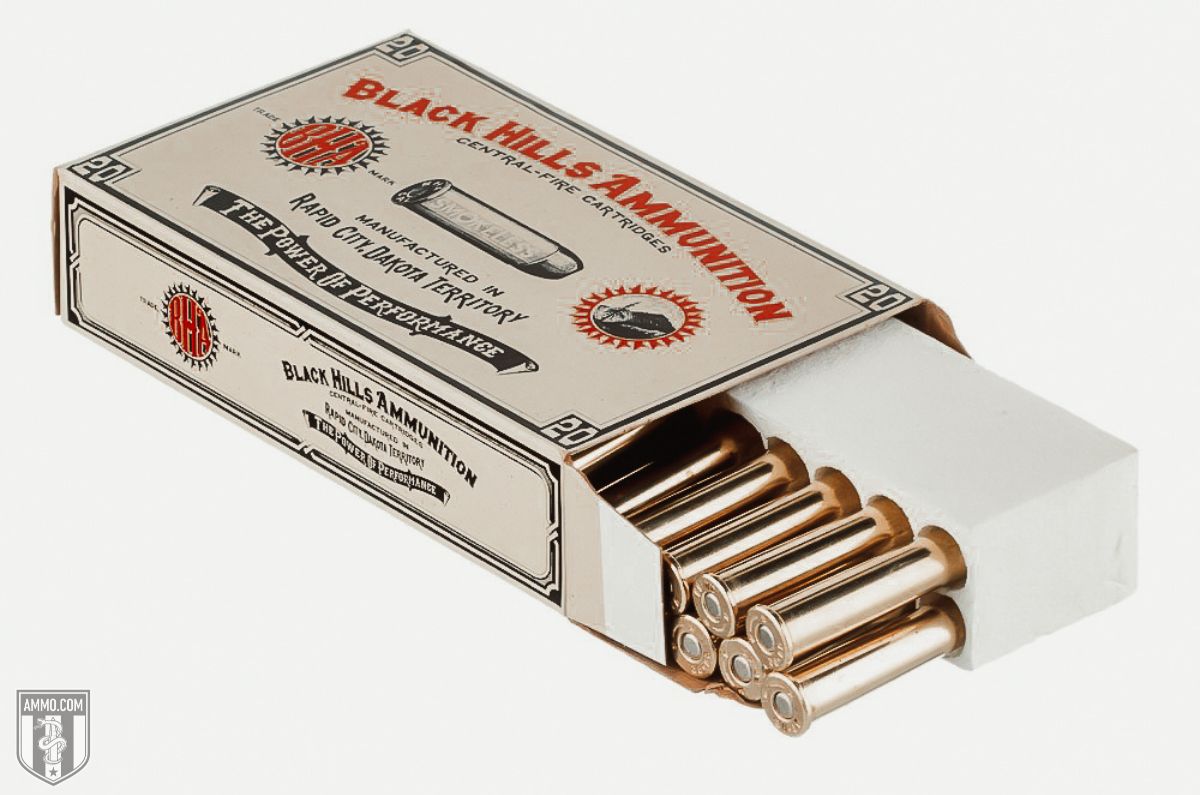
The 38-55 is best when deer hunting, black bear hunting, or varmint hunting at close ranges of 300 yards or less.
The 45-70 shines when big game hunting for brown bear, elk, and moose. However, it can be used when hunting whitetail deer and other medium-sized game without damaging too much meat.
However, if you only plan to hunt with these rounds, I would suggest reconsidering.
There are better rounds like the 6.8 Western or 6.5 PRC, designed for hunting that offer a more comprehensive range of applications, and they're more effective at longer ranges.
If you're sensitive to recoil, I would go with the 38-55 for hunting purposes.
However, if you're not as concerned with the recoil, the 45-70 is better because you can hunt a wider variety of animals with it.
The .45-70 wins this category.
.45-70 vs 38-55: Self-Defense
I don't recommend either caliber for self-defense or home defense for several reasons.
The primary reason is that these calibers are most often chambered in single-shot rifles or lever-action rifles. This means you'll be forced to reload much quicker than most semi-auto guns.
Another reason is that they're more likely to over-penetrate. You endanger your family and neighbors even if you shoot the intruder.
If you're worried about overpenetration, I suggest using a 12 gauge for home defense and a .45 ACP or 9mm for self-defense.
The one time I recommend the 45-70 as a self-defense firearm is when you're defending yourself against bears, but when protecting yourself from humans, there are many other better options.
If all you have is one of these guns to protect yourself, then, by all means, use it! I'm only saying I wouldn't use either caliber since I have other options.
Both calibers lose this section, so it's a draw.
Ammo Cost/Availability
Both calibers have been around for over 100 years, so it's safe to say the ammo is available in many places and manufactured by companies such as Winchester, Buffalo Bore, HSM Cowboy Action Ammunition, Remington, Hornady, and Barnes.
However, the 45-70 is the easiest to find because it's more popular than the 38-55.
As far as pricing goes, neither is cheap to shoot.
A cheap round of 45-70 will cost $2.10. That's over $2 for each trigger pull.
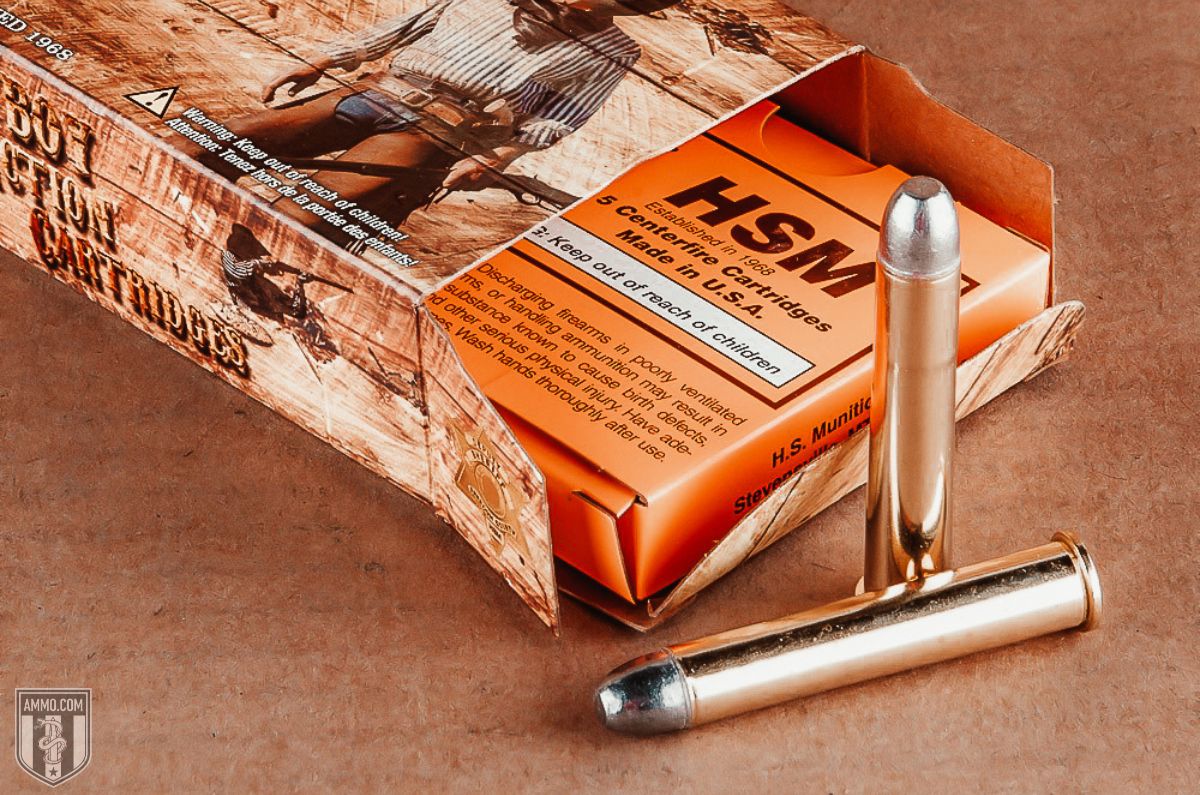
Since the 38-55 isn't as popular, ammo is a little more expensive and will cost $2.27 per trigger pull.
The .45-70 Govt wins this section.
Rifle Cost/Availability
Despite both calibers being well established, more rifles are chambered in 45-70 than 38-55.
Henry, Cimmaron, Taylors & Company, and Winchester are the primary manufacturers of 38-55 rifles.
Henry, Marlin, Winchester, Uberti, Taylors & Company, Chiappa, and CVA all make a 45-70 rifle.
The prices are comparable; however, it's much easier to find an inexpensive .45-70 Govt rifle.
A CVA Scout V2 rifle chambered in 45-70 costs $400, whereas a Taylors & Co 1885 High Wall costs $830. There are great deals on used guns; these were the best prices on new guns at the time of this writing.
Not all .45-70 leverguns are cheap; for instance, the Winchester Model 1886 costs well over $1,600, and the Chiappa 1874 Sharps rifle is only slightly cheaper at $1,400.
The .45-70 wins again; I'm sure you're beginning to see a pattern.
Reloading
An excellent way to save money on ammo is to buy in bulk; an even better way is to reload.
Initially, it's more expensive because you have to buy the reloading press, dies, brass cleaner, and several other items, but if you shoot a lot, it evens out in the long run.
Handloading gives you control over the controllable variables.
Factory ammo isn't as consistent as hand-loaded ammo because factory loads have a range of allowable variances, whereas when handloading, you get to be as precise as possible.
This is why most competitive shooters reload their ammo.
Another reason to reload these calibers is that they're not commonly carried at most sporting goods stores.
Depending on your gun, you may or may not need hard-cast bullets to help it shoot more accurately. While they are available in factory loads, you have the option of pouring your own using a mold when reloading.
Reloading supplies and information for both rounds are readily available, so this section is a tie.
Ballistics
Below you'll find the ballistics of each caliber. Keep in mind this is generalized and won't be specific to the rounds you're firing and the gun from which you're firing them.
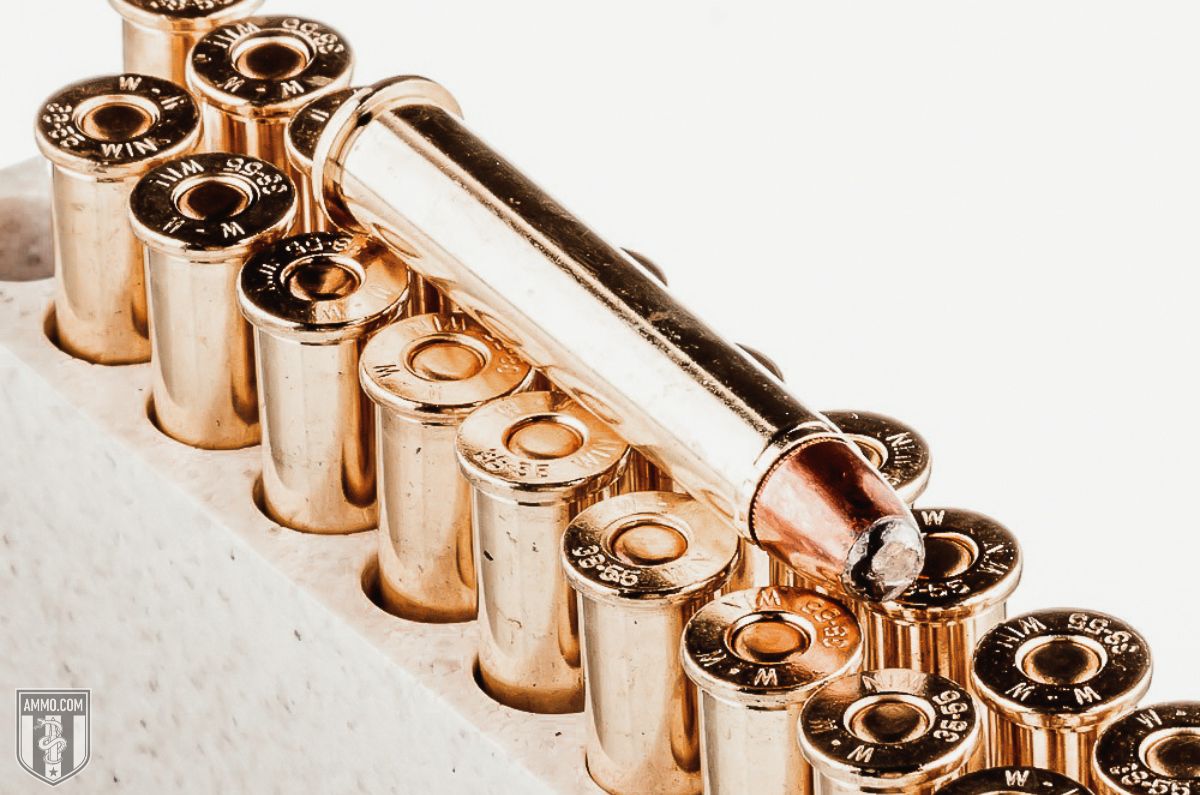
38 55 Ballistics
The .38-55 muzzle velocity range of 1,800-2,300 fps. The muzzle energy ranges from 1,834-2,994 ft-lbs. We've already touched on the trajectory, but when zeroed in at 100 yards, the .38-55 has a bullet drop of 7.79".
45 70 Ballistics
Note: This information comes from the manufacturer and is for informational purposes only. The actual ballistics obtained with your firearm can vary considerably from the advertised ballistics. Also, ballistics can vary from lot to lot with the same brand and type load.
| 45-70 Bullet WEIGHT | Muzzle VELOCITY (fps) | Muzzle ENERGY (ft. lbs.) | TRAJECTORY (in.) | |||||||||||
|---|---|---|---|---|---|---|---|---|---|---|---|---|---|---|
| Muzzle | 100 yds. | 200 yds. | 300 yds. | 400 yds. | Muzzle | 100 yds. | 200 yds. | 300 yds. | 400 yds. | 100 yds. | 200 yds. | 300 yds. | 400 yds. | |
| 250 Grain | 2025 | 1616 | 1285 | 1068 | n/a | 2276 | 1449 | 917 | 634 | n/a | 6.1 | 0 | -27.2 | n/a |
| 300 Grain | 1810 | 1497 | 1244 | 1073 | 969 | 2182 | 1492 | 1031 | 767 | 625 | 0 | -14.8 | 0 | 0 |
| 300 Grain Supreme | 1880 | 1558 | 1292 | 1103 | 988 | 2355 | 1616 | 1112 | 811 | 651 | 0 | -12.9 | -46 | -105 |
| 325 Grain | 2000 | 1685 | 1413 | 1197 | n/a | 2886 | 2049 | 1441 | 1035 | n/a | 5.5 | 0 | -23 | n/a |
| 325 Grain Lever Evolution | 2050 | 1729 | 1450 | 1225 | n/a | 3032 | 2158 | 1516 | 1083 | n/a | 3 | -4.1 | -27.8 | n/a |
| 405 Grain | 1330 | 1168 | 1055 | 977 | 918 | 1590 | 1227 | 1001 | 858 | 758 | 0 | -24.6 | 0 | 0 |
| 405 Grain PMC Cowboy | 1550 | 1193 | n/a | n/a | n/a | 1639 | 1280 | n/a | n/a | n/a | 0 | -23.9 | 0 | 0 |
38 55 Development & History
Introduced by Ballard Rifle & Cartridge Company in 1876, the .38-55 Winchester, also known as .38-55 WCF and .38-55 Ballard.
Marlin Firearms had various single-shot rifles and a lever-action chambered in .38-55. Winchester also had rifles chambered in this caliber until about 1940. Since then, Winchester has released a few commemorative edition rifles in 38-55.
The .375 Winchester is the modern version of the .38-55. However, it cannot be fired in older guns because it produces higher pressure than the older guns were not designed to withstand.
45 70 Development & History
The .45-70 is a centerfire rifle cartridge that was developed at the Springfield Armory as a replacement for the .50-70.
In 1873, the .45-70 was chambered in the 1873 Springfield trapdoor action rifle. The military used the .45-70 until shortly after the Spanish-American War. After its end as a military weapon, it exploded in popularity amongst hunters and other shooting enthusiasts.
Magnum Research has a handgun chambered in 45-70. I only have two words for those willing to take a thumping from such a powerful handgun, "good luck."
It is one of the few cartridges that thrived after being converted from black powder cartridges to smokeless powder loads.

Parting Shots
After comparing the 38 55 bs 45 70 in 10 categories, the 45-70 came out on top winning 6/10 sections, while the 38-55 only won 2/10 with two sections ending in a tie.
However, that doesn't mean you should rush out and purchase a .45-70.
The .38-55 is the better option for new shooters and those sensitive to recoil.
The .45-70 Govt is the best option for big game hunters, and shooting longer distances than the 38-55 is capable of shooting.
Ammo Comparisons
- .308 vs 5.56
- 6.5 Creedmoor vs .308
- .300 Blackout vs .308
- .300 Win Mag vs .308
- .243 vs .308
- .308 vs .30-06
- 7mm-08 vs .308
- .270 vs .308
- 7.62x39 vs .308
- .223 vs .308
- .338 Lapua vs .308
- .380 ACP vs 9mm
- .223 vs 5.56
- .300 Blackout vs 5.56
- 9mm vs 45 ACP
- 9mm vs 40 S&W
- .357 SIG vs 9mm
- 10mm vs 9mm
- 9mm vs 9mm Luger
- .243 vs .270
- .300 Win Mag vs .30-06
- .270 vs .30-06
- .40 vs .45
- 38 Special vs 357
- 9mm vs 40 vs 45
- 5.56 vs 7.62x39
- 338 Lapua vs .30-06
- .30-30 vs .30-06
- 300 PRC vs 338 Lapua
- .30-06 vs 7mm
- 300 Win Mag vs 338 Lapua
- 300 PRC vs 300 Win Mag
- 300 WSM vs 300 Win Mag
- 338 Win Mag vs 338 Lapua
- 12 Gauge vs 20 Gauge
- 10mm vs 357 Mag
- .30-30 vs 7.62x39
- 224 Valkyrie vs 22-250
- 17 HMR vs 22 Mag
- 7.62x39 vs .300 Blackout
- 45 ACP vs 45 Auto
- 45-70 vs 30-30
- 300 Blackout vs 223
- 357 Magnum vs 9mm
- 350 Legend vs 300 Blackout
- 224 Valkyrie vs 223
- 45 ACP vs 38 Super
- 6.5 Grendel vs .308
- 17 HMR vs 22 LR
- 10 Gauge vs 12 Gauge
- 22-250 vs 223
- 45 Colt vs 45 ACP
- 350 Legend vs 30-30
- 5.7x28 vs 223
- 5.7 vs 9mm
- 5.56 vs 5.7
- 22 vs 9mm
- Buckshot vs Birdshot
- 450 Bushmaster vs 308
- 450 Bushmaster vs 223
- Buckshot vs Slug
- 6.5 Grendel vs 5.56 vs 223
- 6mm ARC vs 6.5 Grendel
- 44 vs 45
- 458 SOCOM vs 5.56
- 357 vs 44
- 32 ACP vs 380
- 300 Win Mag vs 338 Win Mag vs 338 Lapua Mag
- 450 Bushmaster vs 458 SOCOM vs 50 Beowulf
- 6mm Creedmoor vs 6.5 Creedmoor
- TMJ vs FMJ
- 44 Special Vs 44 Magnum
- 45 90 vs 45 70
- 6.8 Western vs 6.8 SPC
- 50 Beowulf vs 50 BMG
- 26 Nosler vs 6.5 PRC
- 28 Gauge vs 410
- 6.8 SPC vs 5.56
- 6.8 SPC vs 6.5 Grendel
- 6.8 Western vs 7mm Rem Mag vs .28 Nosler
- 6.8 Western vs 6.5 Creedmoor
- 22 Hornet vs 223
- 6.8 Western vs 6.5 PRC
- .410 vs 12 Gauge
- .410 vs 20 Gauge
- 22 LR vs 22 Mag
- 6mm ARC vs 243
- 7mm-08 vs 270
- 243 vs 6.5 Creedmoor
- Nickel vs Brass Casing
- 204 Ruger vs 223
- 50 Beowulf vs 5.56
- 260 Remington vs 6.5 Creedmoor
- 6mm Remington vs 243
- 28 Nosler vs 300 PRC
- 50 Beowulf vs 50 AE
- 22 Nosler vs 22-250
- 450 Marlin vs 45-70
- 300 Win Mag vs 300 Norma
- 458 SOCOM vs 300 Blackout
- 38-55 vs 45-70
- 22 Hornet vs 22 LR
- 300 Norma vs 338 Lapua
- 338 Lapua vs 50 BMG
- 28 Nosler vs 300 Win Mag
- 28 Nosler vs 6.5 Creedmoor
- 204 vs 22-250
- 458 SOCOM vs 45 70
- 44 40 vs 45 70
- 6.8 SPC vs 6.5 Creedmoor
- 450 Bushmaster vs 30-06
- 7mm Rem Mag vs 300 Win Mag
- 30 Carbine vs 223
- 25-06 vs 30-06
- 26 Nosler vs 28 Nosler
- 16ga vs 12ga
- 30 06 vs 7.62 x54R
- 9mm Makarov vs 9mm Luger
- 350 Legend vs 223
- 30 Carbine vs 5.56
- 6.5x55 vs 6.5 Creedmoor
- 6.5 Creedmoor vs 270 vs 25-06
- M193 vs M855
- 450 Bushmaster vs 458 SOCOM
- 6.5 Grendel vs 6.5 Creedmoor
- 350 Legend vs 5.56
- .277 Fury vs 6.8 SPC
- 277 Fury vs 300 Win Mag
- 10mm vs .45 ACP
- 277 Fury vs 223
- 6.8 SPC vs 300 Blackout
- 6.5 PRC vs 6.5 Creedmoor
- 277 Fury vs 308
- 277 Fury vs 6.5 Creedmoor
- 350 Legend vs 450 Bushmaster
- 277 Fury Vs 5.56 NATO
- 10mm vs 40S&W
- 32 ACP vs 9mm
- 32 Special vs 9mm
- 8.6 Blackout vs 300 Blackout
- 30 Super Carry vs. 9mm
- 5.56 vs 9mm
- .50 Action Express vs 9mm
- 7.62x25 vs. 9mm
- 10mm vs 44 Magnum
- 300 Blackout vs 300 Win Mag
- 6.5 Grendel vs 300 Blackout
- 460 Rowland vs 10mm
- 300 RUM vs 300 PRC
- 300 Norma vs 300 PRC
- 45 GAP vs 45 ACP
- 7mm PRC vs 300 Win Mag
- 300 PRC vs 6.5 Creedmoor
- 300 PRC vs 308
- 357 SIG vs 357 Mag
- 7.62x39 vs 7.62x51
- 243 Win vs 223 Rem
- 30 Nosler vs 300 PRC
- 6.5 Creedmoor vs. 30-06 Springfield
- 450 S&W vs. 44 Magnum
- 6.5 Creedmoor vs. 300 Win Mag
- 454 Cassull vs. 45-70 Govt
- 454 Cassull vs. 44 Mag
- 7.62x54r vs. 308 Winchester
- 22 ARC vs. 223 Rem
- Subsonic vs. Supersonic Ammo

